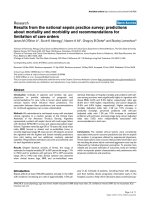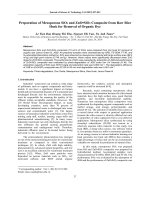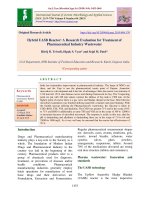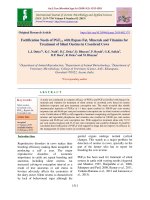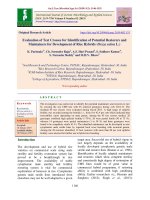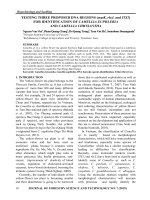Renewable hybrid nanocatalyst from magnetite and cellulose for treatment of textile effluents
Bạn đang xem bản rút gọn của tài liệu. Xem và tải ngay bản đầy đủ của tài liệu tại đây (3.17 MB, 7 trang )
Carbohydrate Polymers 163 (2017) 101–107
Contents lists available at ScienceDirect
Carbohydrate Polymers
journal homepage: www.elsevier.com/locate/carbpol
Renewable hybrid nanocatalyst from magnetite and cellulose for
treatment of textile effluents
Ana Carolina Cunha Arantes a , Crislaine das Grac¸as Almeida a ,
Ligiane Carolina Leite Dauzacker a , Maria Lucia Bianchi a , Delilah F. Wood b,∗ ,
Tina G. Williams b , William J. Orts b , Gustavo Henrique Denzin Tonoli c
a
Department of Chemistry, Federal University of Lavras, CP 3037 Lavras-MG, Brazil
Bioproducts Research Unit, WRRC, ARS-USDA, 800 Buchanan St., Albany, CA 94710, USA
c
Department of Forest Sciences, Federal University of Lavras, CP 3037 Lavras-MG, Brazil
b
a r t i c l e
i n f o
Article history:
Received 17 November 2016
Received in revised form
27 December 2016
Accepted 4 January 2017
Available online 7 January 2017
Keywords:
Magnetite
Catalyst
Cellulose
Nanofibrils
Crystallite
a b s t r a c t
A hybrid catalyst was prepared using cellulose nanofibrils and magnetite to degrade organic compounds.
Cellulose nanofibrils were isolated by mechanical defibrillation producing a suspension used as a matrix
for magnetite particles. The solution of nanofibrils and magnetite was dried and milled resulting in a
catalyst with a 1:1 ratio of cellulose and magnetite that was chemically and physically characterized
using light, scanning electron and transmission electron microscopies, specific surface area analysis,
vibrating sample magnetometry, thermogravimetric analysis, Fourier transform infrared spectroscopy, Xray diffraction, catalytic potential and degradation kinetics. Results showed good dispersion of the active
phase, magnetite, in the mat of cellulosic nanofibrils. Leaching and re-use tests showed that catalytic
activity was not lost over several cycles. The hybrid material produced was tested for degradation of
methylene blue dye in Fenton-like reactions resulting in a potential catalyst for use in degradation of
organic compounds.
Published by Elsevier Ltd.
1. Introduction
Cellulose has been studied and applied as a precursor of new bioengineered materials (Oksman et al., 2016; Reza et al., 2015; Zhu
et al., 2015) and is organized at a macromolecular level into fibrils
consisting of glucose units in a linear and crystalline arrangement,
along with hemicellulose and lignin (Fengel & Wegener, 1984;
Zugenmaier, 2008). Cellulose fibers are made up of basic crystalline
building-blocks or nanofibrils that can form suspensions in water
when isolated (Chen et al., 2014).
The isolation process, typically by chemical or physical methods, can affect the properties of the resulting cellulose nanofibrils
(Wang, Li, Yano, & Abe, 2014). Mechanical defibrillation is a physical
process where cellulose fibers pass through a mill that reduces their
∗ Corresponding author.
E-mail addresses:
(A.C.C. Arantes), fla.br (C.d.G. Almeida),
(L.C.L. Dauzacker), fla.br (M.L. Bianchi),
(D.F. Wood), (T.G. Williams),
(W.J. Orts), fla.br (G.H.D. Tonoli).
/>0144-8617/Published by Elsevier Ltd.
dimensions by friction. At a certain size range, the nanofibrils form
a gel-like suspension (Bufalino et al., 2015; Fonseca et al., 2016).
Defibrillation is a physical method that requires no chemicals in
the isolation of cellulose nanofibrils, thus, reduces processing steps
and pollution.
Cellulose nanofibrils can be used to prepare a multitude of useful commercial materials, such as aerogels, xerogels, hydrogels,
beads and specialty biomaterials (including medical grafts) (Abe
& Yano, 2011; Baetens et al., 2011; Chin, Binti Romainor, & Pang,
2014; Eichhorn et al., 2010; Gericke et al., 2013; Wan & Li, 2015).
Aerogels have low density, high strength and a large surface area
(Innerlohinger, Weber, & Kraft, 2006) and are produced by supercritical drying of cellulose nanofiber suspensions which allows
them to maintain a structured gel (Heath & Thielemans, 2010). Air
drying of nanofiber suspensions causes the gel structure to collapse
resulting in a xerogel (Baetens et al., 2011). Depending on the final
application, a xerogel may have the same benefits of an aerogel
without the high costs of supercritical drying.
Aerogels and xerogels made from cellulose can serve as fixed
supports for Fe ions in the production of chemical catalysts (Small
& Johnston, 2009). These Fe-hybridized aerogels can be expected
102
A.C.C. Arantes et al. / Carbohydrate Polymers 163 (2017) 101–107
to be used in a number of industrial applications as they have
superparamagnetic properties, remarkable mechanical strength,
are lightweight, flexible, highly porous and have a large surface
area that provide a huge number of reactive sites (Liu, Yan, Tao, Yu,
& Liu, 2012). In addition to being produced from readily renewable
resources, such as wheat straw, an agricultural residue, aerogels
may be prepared using green chemical methods which further
extends their usefulness and acceptability as a green product (Wan
& Li, 2015). Olsson and coworkers used highly flexible and porous
hybrid aerogels as templates to construct solid and stiff nanocomposites by compaction (Olsson et al., 2010). Fe ions may be used
to catalyze Fenton-like reactions for the generation of hydroxyl
radicals using strong oxidizing agents, such as H2 O2 , as a precursor. Hydroxyl radicals have high oxidation potential and can
degrade organic molecules, such as dyes generated in textile effluents (Nogueira, Trovó, Da Silva, Villa, & De Oliveira, 2007).
The use of iron-based catalyst systems is advantageous because
iron is a naturally-occurring, abundant compound that is nontoxic, environmentally safe and readily renewable and sustainable.
Some forms of iron oxide have magnetic properties facilitating the
removal of reactants so that they can be readily reused (Luo &
Zhang, 2009). Magnetite, a dark colored iron oxide, with the molecular formula Fe3 O4 , provides magnetic properties to materials and
supplies Fe ions to catalyze Fenton- like reactions.
The aim of this study was to evaluate the catalytic efficiency of a
magnetic catalyst produced by impregnating cellulose nanofibrils
with magnetite and applied to the degradation of methylene blue
dye in a Fenton-like reactive process.
2. Materials and methods
2.1. Production and characterization of the cellulose suspension
The fibers of commercial eucalyptus kraft pulp (Jacareí/SP,
Brazil) were immersed in distilled water for 48 h at 1% (w/w) concentration before defibrillation. Cellulose nanofibrils were obtained
by mechanical defibrillation of the fiber cell wall using a SuperMasscolloider MKCA6-3, (Masuko Sangyo Co., LTD, Japan), operated
at 1500 rpm, with a 0.01 mm opening between disks and applying 35 passages through the defibrillator (Bufalino et al., 2015;
Tonoli et al., 2016). The resulting nanofibril suspensions were
characterized morphologically using a Nikon Eclipse E200 (Japan)
compound microscope by randomly selecting 10 areas on a slide for
image analysis. Glass slides were prepared with 0.05 mL of sample
mounted in glycerin.
Scanning electron microscopy (SEM) was performed using a
Hitachi S4700 field emission SEM (Hitachi High-Technologies,
Japan). The freeze-dried samples were adhered to aluminum specimen stubs using double-sided adhesive-coated carbon tabs (Ted
Pella, Inc., Redding, CA). The samples were then sputter-coated
with gold-palladium in a Denton Desk II sputter coating unit
(Moorestown, NJ). SEM images were captured at a resolution of
2650 × 1920 pixels.
Transmission electron microscopy (TEM) was used to visualize
the cellulose nanofibrils by mixing the suspended samples with
uranyl acetate to make the cellulose particles electron dense in
order to provide contrast in the TEM. A drop of the nanofibril suspension was placed onto a 400-mesh carbon-formvar grid (Ted
Pella, Inc., Redding, CA) held at the edge with double-adhesive tape.
The grids were allowed to air-dry and then were observed and photographed in a FEI Tecnai 12 TEM (FEI Company, Hillsboro, OR)
operated at 120 kV. The average diameter of the micro/nanofibrils
was determined by digital image analyses (ImageJ 1.48 v, National
Institutes of Health, USA) on TEM micrographs. A minimum of 100
measurements were collected for analyses.
2.2. Production and characterization of the magnetic hybrids
The synthesis of magnetic material was performed using the
methodology adapted from Schwertmann & Cornell (2000). Fe2+
and Fe3+ salts (6.314 g FeCl3 and 2.343 g FeCl2 ) were dissolved in
200 mL of an aqueous suspension of cellulose nanofibrils under
nitrogen flow. NH4 OH was added until pH 11 was attained to
precipitate both magnetite and cellulose from solution. The precipitate was washed with water until pH ∼ 7, oven-dried at 60 ◦ C,
and milled in a ball mill. The mass ratio of cellulose:magnetite was
1:1 (cel:mag). To obtain the ratio, the experimental sample was
compared to a sample of pure magnetite (magnetite) prepared by
a similar method.
Surface areas were determined via N2 adsorption at −196 ◦ C
in an Autosorb-1 Quantachrome system (Quantachrome Instruments, Boynton Beach, FL). The samples were previously degassed
at 110 ◦ C for 10 h, and the specific area was calculated using
the Brunauer-Emmett-Teller (BET) model. Magnetic properties
of the materials were measured by vibrating sample magnetometry (VSM) using an ADE/DMS Model 880 Vibrating Sample
Magnetometer (MicroSense, LLC, Lowell, MA). Thermogravimetric
analysis (TGA) was performed using a Shimadzu DTG-60AH TGA
(Shimadzu Corporation, Kyoto, Japan). Samples (approximately
10 mg) were heated under synthetic air atmosphere in the range
of 25–800 ◦ C with a heating rate of 10 ◦ C min−1 and a gas flow rate
of 30 mL min−1 . Fourier transform infrared spectroscopy (FTIR) was
performed using a Shimadzu spectrophotometer IRAffinity system,
with KBr pellets containing 1% sample, in the spectral range of
400–4000 cm−1 , 4 cm−1 resolution with 32 scans. X-ray diffraction
(XRD) was performed using a Shimadzu XRD-6000 equipped with
a graphite crystal as monochromator to collimate Cu-K␣1 radiation
at = 1.5406 Å with a step of 0.02◦ s−1 and an angular range (2) of
4◦ –70◦ .
2.3. Catalytic tests
Assays of the catalytic decomposition of H2 O2 by cel:mag were
performed, under stirring, using 30 mg of the cel:mag catalyst, 5 mL
of water and 2 mL of H2 O2 . The volume of oxygen produced was
monitored by displacement of water in a column over 30 min. A
comparative reaction was also run using 30 mg of catalyst, 5 mL
of methylene blue (50 ppm) and 2 mL of H2 O2 . For leaching tests,
60 mg of the cel:mag catalyst were stirred with 10 mL of water for
180 min; then, decomposition of H2 O2 was measured using 5 mL of
the supernatant. For the dye tests, catalytic properties were assayed
via kinetic degradation of methylene blue dye using 10 mg of the
cel:mag catalyst, 9.9 mL of 50 ppm methylene blue solution and
0.1 mL of H2 O2 . Reactions were monitored by spectrophotometry in
UV–vis at 665 nm at 0, 15, 30, 60, 90, 120 and 180 min. All tests were
performed using either the cel:mag or the magnetite catalytic formulations. Moreover, the degradation kinetics were also performed
for pure cellulose.
3. Results and discussion
3.1. Morphology of the cellulose nanofibrils
One feature that determines the presence of nanofibrils is the
formation of an increasingly gel-like suspension with successive
passages through the defibrillator (Nakagaito & Yano, 2004). When
the solution containing cellulose fibers passes through the defibrillator, disintegration of the cell walls occur, thus modifying the
dimensions and surface structure of the fibers. Structural modification results in viscosity changes due to the breaking and
reformation of chemical bonds. The crystallinity index and degree
A.C.C. Arantes et al. / Carbohydrate Polymers 163 (2017) 101–107
103
Fig. 1. Optical microscopy images of cellulose pulp fibers before defibrillation (a) and cellulose nanofibrils obtained by mechanical defibrillation of cellulose fibers (b);
transmission electron microscopy (TEM) micrograph showing the nanofibrils after defibrillation (c); accumulated diameter distribution of the nanofibrils after measurements
using TEM micrographs (d).
of polymerization are also changed with consecutive passages
(Uetani & Yano, 2011). Light microscopy images (Fig. 1a, b) present
the cellulose fibers before and after passages through the defibrillator (35 cycles), and the size changes in the nanofibrils may be
clearly observed. Fig. 1c shows a transmission electron micrograph
(TEM) of the nanofibrils obtained by mechanical defibrillation of
the starting cellulose pulp fibers. Defibrillation decreases the average fiber length significantly and increases the swelling capacity
by fracturing the fibrils, resulting in a considerable increase in surface area (Tonoli, Fuente et al., 2009; Tonoli et al., 2016; Tonoli,
Rodrigues Filho et al., 2009). High shear applied to fibers during
defibrillation efficiently disintegrated fibers into small fragments
and, to some extent, separated individual nanofibrils. The accumulated nanofibril diameter distribution is presented in Fig. 1d. The
average diameter of nanofibrils was 50 ± 41 nm, with roughly 55%
of the nanofibrils at a diameter of less than 40 nm.
The presence of fibers larger than the nanoscale can be observed
in the suspension (content larger than 100 nm in Fig. 1d), although
this did not preclude formation of catalysts since the suspensions
remained stable and well-dispersed with no separation of the cellulose nanofibrils (Fig. 2a). The minimization of steps in the milling
protocol will reduce the production costs of catalysts, an important advantage in large-scale production. The production of catalyst
with cellulose without passing through the defibrillator was also
tested as a control experiment, but these cellulose fibers tended to
cluster and did not form a stable suspension (Fig. 2b). Therefore, the
synthesis of catalysts without defibrillation produced an inhomogeneous solution where the active phase was not well dispersed,
forming magnetite clusters with long fibers of cellulose.
3.2. Properties of the hybrids magnetic materials
A homogeneous magnetic material was produced (cel:mag) that
could be classified as a xerogel since its slow oven-drying would
result in a loss of microporosity. The cel:mag material was milled to
reduce the particle size and to increase the surface area, an important characteristic of a catalyst. The final mass yield for the synthesis
was 94% resulting in a material with amphiphilic (Fig. 2c) and magnetic (Fig. 2d) properties. Both properties increase the application
possibilities in different reaction media and facilitate the reuse of
the material.
Magnetite on its own generally forms clusters in aqueous solutions leading to a loss of activity in Fenton-like processes because
the surface area is reduced thereby reducing access to reactive Fe
ions. To improve the efficiency of the catalyst, the magnetite was
synthesized in association with cellulose nanofibrils. Nanofibrils
maintain a large surface area and since cellulose does not dissolve
in water or organic solvents, it was hypothesized that magnetite
dispersed in cellulose would form a stable solution. Such a dispersed matrix with a large surface area would increase access to
catalytic sites, thus promoting longer catalytic life.
To verify the hypothesis of an increased number of reactive
sites, specific surface area analyses of the materials (cel:mag and
magnetite) and the isotherms of N2 (g) adsorption-desorption were
performed (Fig. 3a). The isotherms present a hysteresis type IV typical of mesoporous materials shown as pore size distribution (Fig. 3a,
insert) with strong adsorbent-adsorbate interactions (Thommes
et al., 2015). The specific surface areas calculated are 30 m2 g−1 and
112 m2 g−1 for magnetite and cel:mag, respectively. The increase
in surface area demonstrates the advantage of using magnetite on
cellulose nanofibrils.
104
A.C.C. Arantes et al. / Carbohydrate Polymers 163 (2017) 101–107
Fig. 2. Cellulose fibers after (a) and before (b) mechanical defibrillation. Note the uneven dispersion of fibers in (b) and the stable and well-dispersed suspension in (a).
The amphiphilic property of the hybrid catalyst demonstrated when the catalyst remains in the interface of organic phase and aqueous mixture (c) magnetic property
demonstrated when the hybrid catalyst is attracted by a magnet (d).
Fig. 3. (a) N2(g) adsorption-desorption isotherms (the insert shows the pore size distribution) and (b) hysteresis cycles (the insert shows the initial magnetization curve as a
function of applied magnetic field) of the hybrid catalyst synthetized with cellulose nanofibrils and magnetite (Cel:Mag) and pure magnetite (Magnetite).
The magnetic properties were studied by performing a VSM
analysis and Fig. 3b exhibits the hysteresis loop of the materials. The
hysteresis and coercivity of samples are characteristic of superparamagnetic materials. The saturation magnetization of cel:mag at
29.74 emu/g is comparable to that of pure magnetite at 31.58 emu/g
indicating that the cellulose matrix doesn’t affect the superparamagnetic property of the magnetite.
Interactions and dispersions of magnetite and cel:mag were
observed via SEM and image analysis (Fig. 4). Pure magnetite
forms clusters (Fig. 4a) that do not disperse in aqueous media. The
cel:mag also forms clusters; however, the magnetite clusters are
distributed in a web of cellulose nanofibrils (Fig. 4b). The cel:mag
clusters have an increased surface area over the magnetite clusters
which increases the access to catalytic sites in the cel:mag material. Since cellulose is water insoluble, the system remains stable,
with materials well-dispersed in the reaction medium. Recovery of
the magnetic material from the stable matrix is much faster than
from the unstable matrix (magnetite alone) thus, making it much
easier to re-use the nanofibril catalyst than it is to recover the pure
magnetite.
TEM images also show the dispersion of magnetite within the
web of cellulose nanofibrils (Fig. 4c, d). Cellulose does stains lightly
with uranyl acetate, thus cellulose regions are less electron dense
than the magnetite regions, which are electron dense due to their
metallic nature. Thus, in Figs. 4c and 4d, cellulose is relatively lightcolored while magnetite is revealed as dark spots dispersed in the
matrix.
Thermogravimetric analysis (TGA) reveals some mass loss at
about 100 ◦ C related to loss of adsorbed water (Fig. 5). The differential thermogravimetric (DTG) curve shows the temperature
at which the maximum degradation weight loss occurs. At higher
temperatures, the mass losses are related to phase changes, mate-
rial degradation and loss of structural water. Above ∼300 ◦ C
cellulose nanofibrils rapidly lose mass due to their rapid degradation to CO2 and H2 O, with stabilization (near total degradation
with approximately 98% of mass loss) seen at ∼530 ◦ C (Fig. 5a).
For magnetite, a small mass loss occurs at around 200 ◦ C related
to adsorbed water. After this, no mass loss is seen; however, an
exothermic event is observed in the DTG curve (Fig. 5b) related to
conversion of magnetite to maghemite. Magnetite can also convert
directly to hematite but this conversion does not appear in the DTG
curve (Cornell and Schwertmann, 2003). The maghemite (␥-Fe2 O3 )
and hematite (Fe2 O3 ) are iron oxides such as magnetite, but with
different compositions and molecular arrangements. As expected,
for the 1:1 cel:mag hybrids produced here (Fig. 5c), a 50% mass
loss related to degradation of cellulose nanofibrils was confirmed
with a change in DTG curve at around ∼300 ◦ C corresponding to
energy release. The other 50% of the mass is magnetite, which is
not expected to degrade within this temperature range.
Fig. 6a shows the FTIR spectra of the samples. For cellulose nanofibrils, bands are observed corresponding to OH groups
at around 3600 and 3200 cm−1 ; stretching of the CH bond at
2900 cm−1 ; deformation of primary and secondary OH groups at
1640 cm−1 and 1400 cm−1 region; stretched CO group at 1100 cm−1
and bands related to alcohol groups below 1000 cm−1 (Silverstein &
Webster, 1997). For magnetite, the characteristic bands are below
600 cm−1 and it is possible to identify a band at 590 cm−1 related
to FeO interactions (Cornell & Schwertmann, 2003). For cel:mag,
characteristic bands related to cellulose were seen, and the band of
FeO that is interesting to catalysis, showing that Fe is available in
the material.
Fig. 6b shows the X-ray diffractograms with some characteristic
and well-defined peaks, at around 18◦ and 22◦ (Zugenmaier, 2008)
corresponding to cellulose nanofibrils indicative of the presence of
A.C.C. Arantes et al. / Carbohydrate Polymers 163 (2017) 101–107
105
Fig. 4. Typical electron micrographs of a cluster of synthetized pure magnetite (a) and the hybrid catalyst (cel:mag) synthetized with cellulose nanofibrils and magnetite
showing the magnetite dispersed into the web of the cellulose nanofibrils (b) viewed by scanning electron microscopy (SEM). The hybrid catalyst (cel:mag) synthetized with
cellulose nanofibrils and magnetite showing the magnetite dispersed into the web of the cellulose nanofibrils (c, d) viewed by transmission electron microscopy (TEM).
Fig. 5. Typical thermograms of thermogravimetric analysis (TGA) and differential thermogravimetric (DTG) curves of cellulose nanofibrils obtained with mechanical
defibrillation (a); synthetized pure magnetite (b); and the hybrid catalyst (cel:mag) obtained with cellulose nanofibrils and magnetite (c).
crystalline phases and agreeing with the findings of Vivekanandhan for microcrystalline cellulose. Well-defined peaks are observed
for magnetite also indicating its crystalline character (shown with
an enlarged scale since the intensity is much lower than that of
pure cellulose) (Vivekanandhan, Christensen, Misra, & Mohanty,
2012) and confirming the efficiency of the synthesis. The magnetite diffractogram, according to the JCPDS data library (card
number 88–315 for magnetite) refers to an iron oxide with a cubic
crystalline phase (Sasaki, 1997). For cel:mag, the diffractogram is
practically identical to pure magnetite, with near perfect overlap,
indicating that magnetite is well-dispersed within the matrix material.
3.3. Catalytic properties
Catalytic potential of materials could be verified by performing a
decomposition of H2 O2 because this reaction, in consecutive steps,
generates free radicals, highly reactive species that attack most
organic molecules (Munoz, de Pedro, Casas, & Rodriguez, 2015).
The reaction is monitored by measuring the formation of oxygen
that is proportional to the decomposition of peroxide according the
reaction H2 O2 → H2 O + ½ O2 . The results for cel:mag and pure magnetite (Fig. 7) show that both materials decompose H2 O2 which is
evidenced by the increase in oxygen evolution over time. Magnetite
generates a larger volume of oxygen than cel:mag under similar
conditions perhaps due to the presence of twice the amount of Fe
in pure magnetite compared to cel:mag. Cel:mag contains a 1:1
ratio of cellulose and magnetite.
A Fenton-like process is a complex reaction and the exact mechanism is difficult to predict in heterogeneous systems. More details
about the possible Fenton degradation mechanisms were reported
elsewhere (He, Yang, Men, & Wang, 2016; Munoz et al., 2015).
There is evidence that Fe2+ and Fe3+ catalyze the generation of free
hydroxyl radicals that degrade most organic compounds (He et al.,
106
A.C.C. Arantes et al. / Carbohydrate Polymers 163 (2017) 101–107
(a)
(b)
Fourier transform infrared (FTIR) spectroscopy
X-ray Diffraction (XRD) Patterns (Intensity)
120
100
Transmittance (%)
Magnetite
Cel:Mag
2000
Cellulose
8000
80
Cellulose
Magnetite
Cel:Mag
6000
1600
1200
60
4000
40
800
Cellulose
Magnetite
Cel:Mag
20
2000
0
3500
2500
1500
500
Wavenumber (cm -1)
400
0
0
5
25
45
65
2Θ
Cellulose), synthetized pure magnetite
Fig. 6. (a). Typical Fourier transform infrared (FTIR) spectra of cellulose nanofibrils obtained with mechanical defibrillation (
Magnetite), and the hybrid catalyst obtained with cellulose nanofibrils and magnetite (
Cel:Mag) and (b). X-ray diffraction (XRD) patterns of cellulose nanofibrils
(
Cellulose) using the scale on the left; and synthetized pure magnetite (
Magnetite) and the hybrid catalyst obtained with
obtained with mechanical defibrillation (
cellulose nanofibrils and magnetite (
Cel:Mag) using the scale on the right.
Oxygen Evolution Over Time
Volume of Oxygen (mL)
10
Cel:Mag
Cel:Mag Leached
Magnetite
Magnetite Leached
8
6
4
2
0
0
5
10
15
20
25
30
Time (min)
Fig. 7. Oxygen evolution over time in reactions of H2 O2 decomposition using the
Cel:Mag),
hybrid catalyst obtained with cellulose nanofibrils and magnetite (
Magnetite), the leached hybrid catalyst (
Cel:Mag
pure magnetite (
Magnetite Leached) as catalysts.
Leached) and leached pure magnetite (
2016; Munoz et al., 2015; Nidheesh, Gandhimathi, & Ramesh, 2013;
Pouran, Raman, & Daud, 2014). Therefore, in order to maintain catalytic activity and re-use the material for multiple cycles, Fe ions
should be available on the surface of the catalyst and should not
leach out with time. Leaching tests, using the supernatant of water
and catalysts (cel:mag leached and magnetite leached), were performed to determine if Fe was lost from the catalyst to the reaction
medium, resulting in a loss of catalytic activity. If Fe leaches, H2 O2 is
decomposed by a homogeneous catalysis using the supernatant of
a catalyst solution. Fig. 7 shows the results of H2 O2 decomposition
using the leached materials and shows that no significant evolution
of oxygen was observed, indicating that magnetite and cel:mag are
not losing catalytic activity.
The maintenance of catalytic activity was confirmed over 10
consecutive cycles of methylene blue decomposition (9.9 mL at
50 ppm, for 180 min) using the same catalyst sample with >95% discoloration for all 10 cycles (Fig. 8a). Catalytic potential of cel:mag
and magnetite was evaluated by degradation kinetics using methylene blue as the organic compound (Fig. 8b). The degradation was
monitored by measuring the discoloration of the solution spectroscopically at 665 nm (Dhar, Kumar, & Katiyar, 2015). Methylene
blue is a dye used as a model for de-activating a pollutant and the
effectiveness of this degradation reaction indicates that the cel:mag
catalyst could be used in treatment of effluents that generate large
quantities of organic waste.
In 180 min, complete and 90% discoloration of methylene
blue solution was observed following exposure to cel:mag and
magnetite, respectively, indicating degradation of the organic
compound. Degradation kinetics is similar for both cel:mag and
magnetite. However, cel:mag contains half the amount of magnetite as pure magnetite since half of the mass is cellulose; i.e., a 1:1
cel:mag has 5 mg of magnetite compared to 10 mg for pure magnetite. The positive results seen in Fig. 8b are likely due to the fact
that Fe ions were more available in the cel:mag hybrid than in the
magnetite, leading to similar reaction rates with the half amount
of magnetite. The degradation kinetics performed with pure cellu-
Fig. 8. Catalytic potential in consecutive cycles reusing the same amount of hybrid catalyst (cel:mag) obtained with cellulose nanofibrils and magnetite (a) and degradation
Cel:Mag), pure magnetite (
Magnetite) and pure cellulose (
Cellulose) as catalysts (b) demonstrated in measures of
kinetics using the hybrid catalyst (
discoloration (%) of methylene blue solution (50 ppm).
A.C.C. Arantes et al. / Carbohydrate Polymers 163 (2017) 101–107
lose showed less than 6% discoloration (Fig. 8b), proving that Fe is
necessary for catalysis and that discoloration of the solution is not
due the absorption of dye by the cellulose.
4. Conclusions
A renewable hybrid catalyst was successfully produced from
magnetite and cellulose nanofibrils. The material has potential to be
used in Fenton-like reactions to degrade organic compound pollutants. Fe ions present in magnetite catalyzed the generation, from
H2 O2 , of hydroxyl radicals that degraded methylene-blue dye, a
compound present in textile effluents. Cellulose nanofibrils were
produced by mechanical defibrillation, resulting in a suspension
of nanofibrils with an average diameter of 50 ± 41 nm; 55% of the
nanofibrils had diameters <40 nm. The synthesis of the hybrid catalyst, cel:mag, was verified by performing SEM, TEM, surface area
measurements, VSM, TGA, FTIR and XRD analyses and the results
showed good dispersion of the magnetite on cellulosic surfaces.
Leaching and re-use tests of the catalytic materials showed that
they did not lose catalytic activity and can be used for multiple
cycles. Degradation kinetics of H2 O2 and methylene blue show
complete (100%) and 90% discoloration within 180 min with the
cel:mag hybrid and magnetite, respectively. Results showed that
the magnetite (active phase), when dispersed in the cellulosic
matrix, degrades methylene blue dye, a model organic pollutant,
at the same rate with less catalyst.
Acknowledgments
The authors thank: the National Council for Scientific and Technological Development (CNPq), Coordination for the Improvement
of Higher Level Personnel (CAPES) and The Minas Gerais State
Research Foundation (FAPEMIG) for financial support; Departments of Chemistry and Forestry Sciences at Federal University
of Lavras for their outstanding infrastructure support; USDA,
Bioproducts from Agricultural Feedstocks, Project Number: 203041000-058-00-D; Ron Weiss (Arkival Technology Corporation,
Nashua, NH) for collecting the magnetometry measurements on
the samples and for providing information for interpretation of the
data; and Luiz Carlos A. Oliveira for surface areas analysis.
References
Abe, K., & Yano, H. (2011). Formation of hydrogels from cellulose nanofibers.
Carbohydrate Polymers, 85(4), 733–737.
Baetens, R., Jelle, B. P., & Gustavsen, A. (2011). Aerogel insulation for building
applications: A state-of-the-art review. Energy and Buildings, 43(4), 761–769.
Bufalino, L., de Sena Neto, A. R., Tonoli, G. H. D., de Souza Fonseca, A., Costa, T. G.,
Marconcini, J. M., & Mendes, L. M. (2015). How the chemical nature of Brazilian
hardwoods affects nanofibrillation of cellulose fibers and film optical quality.
Cellulose, 22(6), 3657–3672.
Chen, W., Abe, K., Uetani, K., Yu, H., Liu, Y., & Yano, H. (2014). Individual cotton
cellulose nanofibers: Pretreatment and fibrillation technique. Cellulose, 21(3),
1517–1528.
Chin, S. F., Binti Romainor, A. N., & Pang, S. C. (2014). Fabrication of hydrophobic
and magnetic cellulose aerogel with high oil absorption capacity. Materials
Letters, 115, 241–243.
Cornell, R. M., & Schwertmann, U. (2003). Introduction to the iron oxides. In R. M.
Cornell, & U. Schwertmann (Eds.), The iron oxides: Structure, properties,
reactions, occurences and uses (2nd ed., pp. 1–7). Weinheim, FRG: Wiley-VCH
Verlag GmbH & Co. KGaA.
Dhar, P., Kumar, A., & Katiyar, V. (2015). Fabrication of cellulose nanocrystal
supported stable Fe(0) nanoparticles: A sustainable catalyst for dye reduction,
organic conversion and chemo-magnetic propulsion. Cellulose, 22(6),
3755–3771.
Eichhorn, S. J., Dufresne, A., Aranguren, M., Marcovich, N. E., Capadona, J. R., Rowan,
S. J., & Peijs, T. (2010). Review: Current international research into cellulose
nanofibres and nanocomposites. Journal of Materials Science, 45(1), 1–33.
Fengel, D., & Wegener, G. (1984). Wood: Chemistry, ultrastructure, reactions. Berlin:
Walter de Gruyter.
Fonseca, C. S., da Silva, T. F., Silva, M. F., Oliveira, I. R. C., Mendes, R. F., Hein, P. R. G.,
& Tonoli, G. H. D. (2016). Eucalyptus cellulose micro/nanofibrils in extruded
fibercement composites. Cerne, 22(1), 59–68.
107
Gericke, M., Trygg, J., & Fardim, P. (2013). Functional cellulose beads: Preparation,
characterization, and applications. Chemical Reviews, 113(7), 4812–4836.
He, J., Yang, X., Men, B., & Wang, D. (2016). Interfacial mechanisms of
heterogeneous Fenton reactions catalyzed by iron-based materials: A review.
Journal of Environmental Sciences (China), 39, 97–109.
Heath, L., & Thielemans, W. (2010). Cellulose nanowhisker aerogels. Green
Chemistry, 12(8), 1448–1453.
Innerlohinger, J., Weber, H. K., & Kraft, G. (2006). Aerocellulose: Aerogels and
aerogel-like materials made from cellulose. Macromolecular Symposia, 244,
126–135.
Liu, S., Yan, Q., Tao, D., Yu, T., & Liu, X. (2012). Highly flexible magnetic composite
aerogels prepared by using cellulose nanofibril networks as templates.
Carbohydrate Polymers, 89(2), 551–557.
Luo, X., & Zhang, L. (2009). High effective adsorption of organic dyes on magnetic
cellulose beads entrapping activated carbon. Journal of Hazardous Materials,
171(1–3), 340–347.
Munoz, M., de Pedro, Z. M., Casas, J. A., & Rodriguez, J. J. (2015). Preparation of
magnetite-based catalysts and their application in heterogeneous Fenton
oxidation – A review. Applied Catalysis B: Environmental, 176–177, 249–265.
Nakagaito, A. N., & Yano, H. (2004). The effect of morphological changes from pulp
fiber towards nano-scale fibrillated cellulose on the mechanical properties of
high-strength plant fiber based composites. Applied Physics A: Materials Science
and Processing, 78(4), 547–552.
Nidheesh, P. V., Gandhimathi, R., & Ramesh, S. T. (2013). Degradation of dyes from
aqueous solution by Fenton processes: A review. Environmental Science and
Pollution Research, 20(4), 2099–2132.
Nogueira, R. F., Trovó, A. G., Da Silva, M. R. A., Villa, R. D., & De Oliveira, M. C. (2007).
Fundaments and environmental applications of Fenton and photo-Fenton
processes. Quimica Nova, 30(2), 400–408.
Oksman, K., Aitomäki, Y., Mathew, A. P., Siqueira, G., Zhou, Q., Butylina, S., &
Hooshmand, S. (2016). Review of the recent developments in cellulose
nanocomposite processing. Composites Part A: Applied Science and
Manufacturing, 83, 2–18.
Olsson, R. T., Azizi Samir, M. A. S., Salazar Alvarez, G., Belova, L., Strom, V., Berglund,
L. A., & Gedde, U. W. (2010). Making flexible magnetic aerogels and stiff
magnetic nanopaper using cellulose nanofibrils as templates. Nature
Nanotechnology, 5(8), 584–588.
Pouran, S. R., Raman, A. A. A., & Daud, W. (2014). Review on the application of
modified iron oxides as heterogeneous catalysts in Fenton reactions. Journal of
Cleaner Production, 64, 24–35.
Reza, M. T., Rottler, E., Tölle, R., Werner, M., Ramm, P., & Mumme, J. (2015).
Production, characterization and biogas application of magnetic hydrochar
from cellulose. Bioresource Technology, 186, 34–43.
Sasaki, S. (1997). Radial distribution of electron density in magnetite, Fe3O4. Acta
Crystallographica Section B: Structural Science, 53(5), 762–766.
Schwertmann, U., & Cornell, R. M. (2000). Iron oxides in the laboratory: Preparation
and characterization (2nd ed.). Weinheim: Wiley-VCH Verlag GmBH.
Silverstein, R. M., & Webster, F. X. (1997). Spectrometric identification of organic
compounds (6th ed.). London: John Wiley & Sons.
Small, A. C., & Johnston, J. H. (2009). Novel hybrid materials of magnetic
nanoparticles and cellulose fibers. Journal of Colloid and Interface Science,
331(1), 122–126.
Thommes, M., Kaneko, K., Neimark, A. V., Olivier, J. P., Rodriguez-Reinoso, F.,
Rouquerol, J., & Sing, K. S. W. (2015). Physisorption of gases, with special
reference to the evaluation of surface area and pore size distribution (IUPAC
Technical Report). Pure and Applied Chemistry, 87(9-10), 1051–1069.
Tonoli, G. H. D., Fuente, E., Monte, C., Savastano Jr, H., Lahr, F. A. R., & Blanco, A.
(2009). Effect of fibre morphology on flocculation of fibre-cement suspensions.
Cement and Concrete Research, 39(11), 1017–1022.
Tonoli, G. H. D., Rodrigues Filho, U. P., Savastano Jr, H., Bras, J., Belgacem, M. N., &
Rocco Lahr, F. A. (2009). Cellulose modified fibres in cement based composites.
Composites Part A: Applied Science and Manufacturing, 40(12), 2046–2053.
Tonoli, G. H. D., Holtman, K. M., Glenn, G., Fonseca, A. S., Wood, D., Williams, T., &
Orts, W. J. (2016). Properties of cellulose micro/nanofibers obtained from
eucalyptus pulp fiber treated with anaerobic digestate and high shear mixing.
Cellulose, 23, 1239–1256.
Uetani, K., & Yano, H. (2011). Nanofibrillation of wood pulp using a high-speed
blender. Biomacromolecules, 12(2), 348–353.
Vivekanandhan, S., Christensen, L., Misra, M., & Mohanty, A. K. (2012). Green
process for impregnation of silver nanoparticles into microcrystalline cellulose
and their antimicrobial bionanocomposite films. Journal of Biomaterials and
Nanobiotechnology, 3, 371–376.
Wan, C., & Li, J. (2015). Synthesis of well-dispersed magnetic CoFe2O4
nanoparticles in cellulose aerogels via a facile oxidative co-precipitation
method. Carbohydrate Polymers, 134, 144–150.
Wang, H., Li, D., Yano, H., & Abe, K. (2014). Preparation of tough cellulose II
nanofibers with high thermal stability from wood. Cellulose, 21(3), 1505–1515.
Zhu, W., Ma, W., Li, C., Pan, J., & Dai, X. (2015). Well-designed multihollow
magnetic imprinted microspheres based on cellulose nanocrystals (CNCs)
stabilized Pickering double emulsion polymerization for selective adsorption
of bifenthrin. Chemical Engineering Journal, 276, 249–260.
Zugenmaier, P. (2008). Crystalline cellulose and derivatives (1st ed.). Berlin: Springer.

